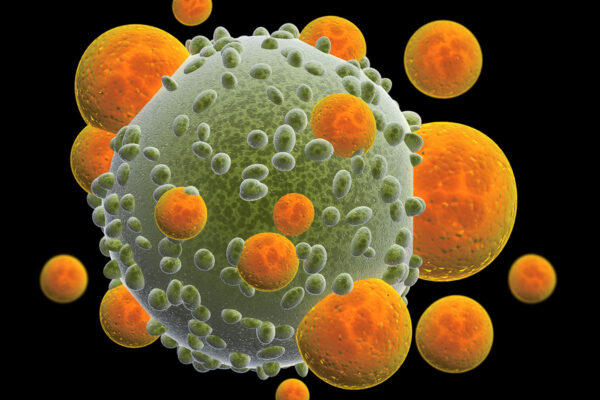Washington University School of Medicine in St. Louis has received a $9 million grant from the National Institutes of Health (NIH) to study the life histories of breast and pancreatic cancers. The grant is part of the NIH’s Human Tumor Atlas Network, a large-scale effort to understand the life span of tumors, including how normal cells become cancerous; how the cancer evolves in response to treatment; and what changes must occur for the tumor to become resistant to therapy and spread.
The Human Tumor Atlas Network is part of the National Cancer Institute’s Cancer Moonshot initiative.
Washington University’s role in the national project is led by principal investigator Li Ding, associate professor of medicine, and three co-principal investigators, Ryan C. Fields, MD, an associate professor of surgery; William Gillanders, MD, a professor of surgery; and Samuel Achilefu, the Michel M. Ter-Pogossian Professor of Radiology. The university’s portion of the research will focus on how breast cancer evolves in response to treatments and how some tumors develop resistance to these treatments. A second project will focus on how pancreatic cancer spreads, or metastasizes, and develops resistance to standard treatments.
The Human Tumor Atlas Network is a follow-up to another NIH-funded large-scale cancer sequencing project called The Cancer Genome Atlas, which centered on sequencing the DNA of primary tumors. According to Ding, the Human Tumor Atlas project is the next step, focusing not only on the primary tumor but on the transition points that cancer goes through as it evolves.
“Primary tumors are rarely what cause cancer deaths,” said Ding, who is also an assistant director of the McDonnell Genome Institute at Washington University. “Tumors that spread or relapse are what becomes deadly. We are now studying the full life cycles of tumors. From cells that become precancerous, to how cancerous cells respond to therapy, to the development of resistance to therapy, to metastasis. We want to understand the transition points.”
Ding said the project will take advantage of the most advanced technologies, making possible studies that could not be conducted until very recently, such as single cell sequencing. The ability to sequence every single cell in a tumor lets researchers identify which portions of a tumor may survive initial therapy and continue growing despite aggressive treatments.
“We are developing 3D maps of tumors and analyzing how those maps change over time,” said Ding, who is also a research member of Siteman Cancer Center at Barnes-Jewish Hospital and Washington University School of Medicine. “We’re not just looking at DNA mutations that lead to cancer. We are building cancer atlases that integrate diverse data sets across many different analysis methods and multidimensional spectrums. These atlases will help us better understand the clonal evolution of the cancer cells, the tumor ecosystem, the development of drug resistance and metastasis. If we can understand how the patient is responding to the tumor invasion, we might be able to find ways to help the body fight against it.
“We are bringing researchers together with broad expertise — from surgery, to genomics, to tumor imaging, to computer science,” Ding added. “We are trying to understand tumors not just as a bulk mass. We want to increase the resolution on these cancers, studying each cell making up the mass and identify what each one is doing.”

Gillanders’ research seeks to harness the immune system to fight cancer, especially the use of vaccines that are specific to a patient’s breast cancer.
“Immunotherapy is a promising new approach to cancer treatment,” Gillanders said. “Studying breast cancers before, during and after immunotherapy will provide unique insights into how cancer immunotherapy works. We hope this will lead to better and less toxic treatments for our patients.”
Fields’ research is focused on efforts to improve treatment for pancreatic cancer, one of the most difficult tumors to treat.

“Pancreatic cancer is highly resistant to standard treatments and, even in the best case scenario, when removed and treated with follow-up chemotherapy and radiation, it has a more than 80 percent chance of coming back,” Fields said.
“The tumor atlas program will allow us to deeply characterize pancreatic cancer with unprecedented precision to understand why it recurs so often and help develop novel treatments.”
Achilefu’s expertise is in biomedical imaging, harnessing radiation therapy to fight cancer and in studying how the tumor responds to such treatments.

“Cancer requires the cooperation of many other cells and a complex supply chain of nutrients and materials to survive,” Achilefu said. “Mapping how these different components interact to fortify tumor territory could reveal a new strategy to eradicate the disease. This award supports a multidisciplinary approach to overcome the multifaceted challenges in accurately mapping the human tumor atlas.
The Human Tumor Atlas Network includes institutions nationwide studying two types of pediatric cancers — a brain tumor called glioma, and acute lymphoblastic leukemia — as well as skin, lung, breast, pancreas and colon cancers in adults. Other medical centers that are members of the network are Harvard University, Boston University, Memorial Sloan Kettering Cancer Center, Stanford University, Vanderbilt University, Duke University, Oregon Health & Science University, Dana-Farber Cancer Institute, the Frederick National Laboratory for Cancer Research, the Broad Institute of MIT and Harvard, and Children’s Hospital of Philadelphia.



Comments and respectful dialogue are encouraged, but content will be moderated. Please, no personal attacks, obscenity or profanity, selling of commercial products, or endorsements of political candidates or positions. We reserve the right to remove any inappropriate comments. We also cannot address individual medical concerns or provide medical advice in this forum.